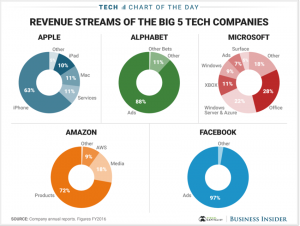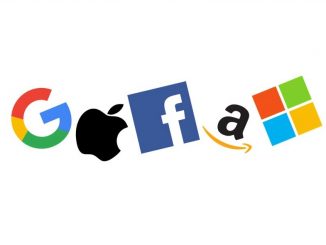
With the arrival of Web2.0, which is a kind of user-oriented Internet product model, digital platform has gradually developed its own business model. The main object of this article is using Instagram as an example to talk about how are those digital platforms profitable.
In order to understand Instagram’s business model, let us first understand its basic overview. Facebook has announced to purchase Instagram in $1 billion in 2012. Up to now, it is estimated that the active users of Instagram will be 1.074 billion in 2021 (eMarketer, 2020), even more than Twitter. We can say that it has become one of the most popular digital platforms in the world. Comparing with the price at which Facebook bought it in 2012, Instagram has brought huge benefits to Facebook, with the estimated annual revenue of $24 billion in 2021 (Iqbal, 2021). How can Instagram make such a huge profits?
Advertising Revenue
The main source of Instagram’s revenue is the advertising revenue. It is estimated that the advertising revenue of Instagram is $20 billion in 2019, which is more than that of YouTube. The advertising revenue growth rate of Instagram is now more than Facebook. Why would that come?
The main purpose of Instagram is to share exquisite videos and pictures. Based on the feature of Instagram, there are generally four kinds of ads on it. Picture Ads, Video Ads, Carousel Ads and Stories Ads. The first two are common, while the Carousel Ads means the advertisers use multiple photos or videos to tell users the brand stories. Users can click the button to jump to other pages to get more information about the brand. Stories Ads can create an immersive viewing experience through video or photos with full screen format. The multiple kinds of ads are more creative and attractive. Comparing to other platforms, users will be easily attracted by these beautiful pictures and videos with filters on Instagram. This can reduce users’ aversion to advertisements and even make them interested in those advertisements. Besides, after being purchased, Facebook provides plenty of mature customers. Thus, advertisers can attract more high-quality users who have distinct personality and obvious preferences.
Here is a video to let you know more about the types of ads on Instagram and how to make ads more attractive on this platform.
9 Types of Instagram Ads | Brandetize. Souce: Youtube – https://www.youtube.com/watch?v=m6LnmhUu4Uc
User’s Data and Algorithm
But how can these platforms accurately deliver ads to the users who will be interested in it to make sure they will view these ads? This is result from automatically data collection. Instagram can collect and sell user’s data to third parties in order to determine the content of the advertisements, giving them details of user behavior and metrics (Van Dijck et al., 2018). Because platforms as multisided businesses should enable different types of customers to interact, collecting and analyzing every user’s data can make them easier to do so.
What’s more, not only using data, the platforms can also use algorithms to determine what kinds of ads and posts are displayed on your page. In that case, the ads on digital platforms are actually more targeted than the traditional media. This is also one reason why platforms like Instagram can make such a huge profits by advertising. There are three factors that Instagram may refer to when implementing the algorithm (Saraco, 2020):
- Relationship with the user. The more the users have interacted with you, the more likely they will be able to see your posts, which is a good way to build loyal customers.
- Interest the user has conveyed. If you have often browsed a certain kind of post, you will have a greater probability to see the content related to it.
- Relevancy of the post. The algorithm would give you a relevancy score when you post something on Instagram. This will effect who it shows in the feed.
However, the strategy of algorithm will not remain the same, it has to tweak frequently in order to adopt the changing marketing tactics, but we can still know a little bit about how does Instagram algorithm work.
Risk of Personal Information Disclosure
Digital platform collecting user’s data has caused more and more users to panic. The feeling of being monitored all the time makes users feel that they have no privacy. Whereas the parent company of Instagram, Facebook, has long been criticized for leaking users’ private information, it is not surprising that Instagram also has such behavior. Actually, Instagram can use the user’s Facebook data to target ads to them, also Facebook can use the data collected from Instagram to target ads to the users cross both platforms. It is said that Instagram has collected 79% of users’ information for profits. This has raised concerns about the security of digital platforms.
In 2020, Instagram was facing the class action lawsuit under Illinois Biometrics Law because of illegally collecting biometric information of its users. Under Illinois Biometrics Law. It alleged that Instagram gather facial recognition data, both from those who signed up for it, and from non-Instagram users who appeared in photos uploaded to the site (Weiss, 2020).
“Once Facebook captures its Instagram users’ protected biometrics, it uses them to bolster its facial recognition abilities across all of its products, including the Facebook application, and shares this information among various entities,” reads the complaint. “Facebook does all of this without providing any of the notices or disclosures required by Illinois law.” (Weiss, 2020).
Although Facebook denied to these allegations, a settlement of $500 million was reached. If Facebook is found responsible, their total loss could reach $500 billion. In this case, the concern about personal information disclosure has raised in recent years, which leads to criticism of such platforms. How to protect out personal privacy on the Internet is a problem worth thinking about.
The ‘Big Five’ Provide Ecosystem
When it comes to Facebook’s acquisition of Instagram, we have to mention the other four leading technology giants. The big five tech giants: Alphabet-Google, Facebook, Apple, Amazon, and Microsoft are operating and dominating the information ecosystem of North American and European (Van Dijck et al., 2018). They provide ecosystem for other platforms. Different platforms provide different online services and have different business models. The structure of revenue streams are also different. Here is a picture to help you understand the revenue stream of the Big Five.

Revenue Streams of The Big 5 Tech Companies. Source: Business Insider, 2018. All rights reserved.
The Big Tech continues to show tremendous growth even amid the ensuing global pandemic. But while they understand and work hard toward constantly enhancing user experience, politicians and some of the public believe they (except for Microsoft) have recently been going overboard and bordering on abusing their users’ data privacy. What we know, though, is that new IT companies can learn a lot from them (Techslang, 2021).
Development Prospect
Nowadays, the line between platforms and infrastructure is blurred. Instagram is now not only a platform, but also a place to buy and sell something. As the development of Instagram and the increasing number of users, it has tried to develop richer business model. For instance, Instagram began to build e-commerce business and integrated independent payment services, enabling consumers to complete consumption functions in this software.
Considering the success of integrating e-commerce and fintech into platform in China, like the WeChat Pay and Alipay which have almost completely substituted for cash pay and credit card, the development of e-commerce on Instagram has a good development prospects. If they can successfully integrate e-commerce into Instagram, this might become a huge source of revenue.
Conclusion
Using the Instagram as a case study, we know the general business model of platforms and how do they work. As the emergence of different types of platforms, there will be more kinds of business models, for example, the popularity of sharing economy in recent year, like Airbnb and Uber. Meanwhile, the business model of digital platforms should evolve from time to time in order to adapt to the changing market and economy.
References
Iqbal, M. (2021). Instagram Revenue and Usage Statistics (2021). Retrieved from https://www.businessofapps.com/data/instagram-statistics/
Saraco, F (2020). Inside the Instagram Algorithm for 2021: How It Works and Where to Shift Your Strategy. Retrieved from https://www.shopify.com/blog/instagram-algorithm
Techslang. (2021). The Big Five Tech Companies: How Did They Make It Big? Retrieved from https://www.techslang.com/the-big-five-tech-companies-how-did-they-make-it-big/
Van Dijck, J., Poell, T. & de Waal, M. (2018) The Platform Society. Oxford: Oxford University Press, pp. 5-32 (‘The Platform Society as a Contested Concept’).
Weiss, E (2020). Instagram Faces Class Action Lawsuit Under Illinois Biometrics Law. Retrieved from https://findbiometrics.com/instagram-gets-hit-bipa-class-action-lawsuit-081711/


